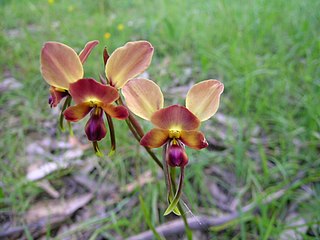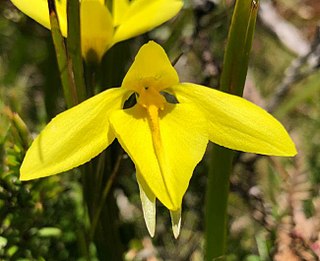
Diuris pardina, commonly known as the leopard orchid or leopard doubletail is a species of orchid which is endemic to south-eastern Australia. It has two or three grass-like leaves and up to ten yellow flowers with reddish-brown marks and blotches.

Diuris sulphurea, commonly called the tiger orchid or hornet orchid, is a species of orchid which is endemic to eastern Australia. It has up to three leaves, and a flowering stem with up to seven bright yellow flowers with dark brown markings.

Diuris protena, commonly known as northern golden moths, is a species of orchid which is endemic to Victoria. It has a tuft of between four and eight leaves at the base and up to three mostly yellow flowers with a few light-coloured marks. It is classed as "endangered" in Victoria.

Diuris chryseopsis, commonly known as common golden moths or the small snake orchid, is a species of orchid that is endemic to south-eastern Australia. It is a common and widespread species growing in woodland, often in colonies and has up to four drooping, golden-yellow flowers. It is similar to several other orchids and form hybrids with some other Diuris species.

Diuris orientis, commonly called the wallflower orchid or eastern wallflower orchid, is a species of orchid which is endemic to eastern Australia. Like others in the genus Diuris, it has two ear-like petals and is similar to the common donkey orchid of Western Australia with which it has been confused. This species is found in New South Wales, Victoria, South Australia and Tasmania and its stalk-like petal "claw" is shorter in than those of D. corymbosa.

Pterostylis basaltica, commonly known as the basalt rustyhood or basalt greenhood is a plant in the orchid family Orchidaceae and is endemic to Victoria. It has a rosette of leaves and eight to fifteen translucent white flowers with green and brown markings and a brownish, insect-like labellum. It is a rare species only known from a small area and is endangered.

Diuris punctata, commonly known as the purple donkey orchid is a species of orchid which is endemic to south-eastern continental Australia. It has two grass-like leaves and up to ten purple or mauve flowers, often with darker, sometimes yellow marks. A yellow form from near Guyra is probably now extinct.
Diuris brevissima is a species of orchid which is endemic to New South Wales. It has two folded leaves and up to nine light yellow flowers with reddish-brown markings. It is a poorly known species that has only been recorded in the Blue Mountains.

Diuris chrysantha, commonly known as granite donkey orchid, is a species of orchid that is endemic to eastern Australia. It has one or two leaves and up to seven deep golden to orange-coloured flowers with brown markings and occurs on the ranges and tablelands north from Tamworth to the Darling Downs.
Diuris fragrantissima, commonly called the fragrant doubletail or Sunshine diuris, is a species of orchid which is endemic to a small area to the west of Melbourne. It has two linear leaves at its base and up to twelve white flowers with mauve or pale purple markings with unusually long lateral sepals. Only about thirty plants survive in grassland near Sunshine.

Diuris gregaria, commonly known as clumping golden moths is a species of orchid that is endemic to Victoria. It between three and seven leaves and one or two bright yellow flowers with a few dark striations and usually grows in dense tufts of up to thirty plants. It is a rare species mostly only found in grassland west of Melbourne.
Diuris immaculata, commonly known as the little Esperance bee orchid, is a rare species of orchid that is endemic to the south-west of Western Australia. It has between four and six leaves and up to three golden yellow flowers without markings. It is only known from near Esperance.

Diuris lanceolata, commonly known as large golden moths, is a species of orchid that is endemic to Tasmania. It has between two and four leaves and up to three golden to orange-yellow flowers with a few dark streaks.

Diuris monticola, commonly known as highland golden moths, is a species of orchid that is endemic to south-eastern Australia. It is a common and widespread, late flowering species growing in grassland and woodland habitats at higher altitudes. It has a tuft of up to nine leaves at the base and up to four slightly drooping bright yellow flowers with dark streaks in the centre.
Diuris ochroma, commonly known as pale goat orchid, or pale golden moths is a species of orchid that is endemic to south-eastern continental Australia. It has three or four leaves at its base and up to four slightly drooping pale yellow flowers with dark reddish purple streaks. It is an uncommon species found in two disjunct populations, in higher parts of each of New South Wales and Victoria.

Diuris palustris, commonly known as the swamp doubletail or swamp diuris is a species of orchid which is endemic to south-eastern Australia. It has a tuft of between eight and ten twisted leaves and up to four yellow flowers with brown spots and blotches marks and blotches.
Diuris secundiflora, commonly known as the one-sided donkey orchid, is a poorly-known species of orchid that is endemic to New South Wales. It has a single grass-like leaf and up to eight yellow flowers that are sometimes spotted and are all arranged on one side of the flowering stem.

Diuris semilunulata, commonly known as the late leopard orchid, is a species of orchid that is endemic to New South Wales and the Australian Capital Territory. It has two grass-like leaves and up to five orange-coloured flowers with brown and purple blotches.
Diuris striata is a poorly-known species of orchid that is endemic to New South Wales. It has a two grass-like leaves and about four mauve flowers with dark purple streaks on the labellum.

Diuris tricolor, commonly known as the long-tailed donkey orchid or pine donkey orchid, is a species of orchid that is endemic to New South Wales, although a single plant has been found in Victoria. It has up to three grass-like leaves and up to six orange-coloured to yellow flowers with white and purplish tints. The lateral sepals are unusually long.















